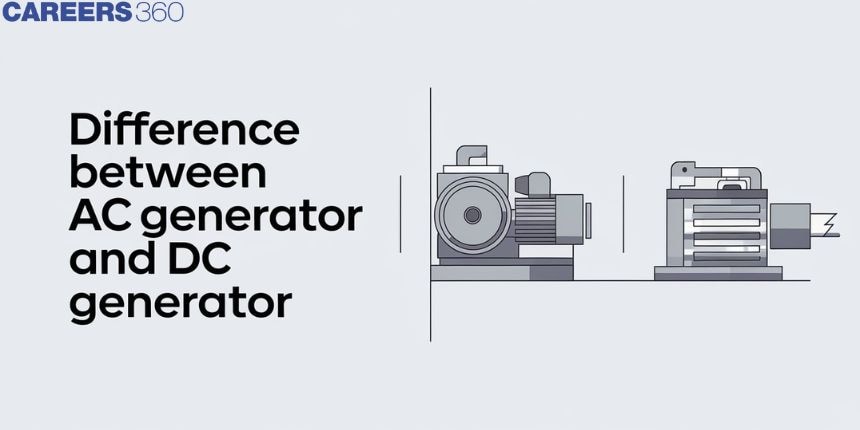Difference Between AC Generator and DC Generator - A Complete Guide
Introduction
‘Generator’ comes from the word generate which means to produce anything itself, here Generator means an object which is used to produce electricity. In this chapter, we will study in detail about AC, DC Generator, its working and application. Later we will see the differences between AC and DC generators. First of all, before learning about AC/DC generators, we should learn about AC/DC.
AC (alternating current): In AC, direction of flow of current changes periodically, whereas
DC (direct current): In DC, there is no change of direction of flow of current.
This Story also Contains
- What is AC/DC Generator?
- Principle of AC/DC generator
- Difference between AC and DC generator:

NCERT Physics Notes :
What is AC/DC Generator?
A device that transforms mechanical energy to electrical energy as alternating current. It is called alternating current generator. A device that transforms mechanical energy to electrical energy as direct current. It is called direct current generator.
Also read -
Principle of AC/DC generator
On the basis of Faraday’s laws of electromagnetic induction, ac or dc generator work. It states: When a conductor is placed inside the magnetic field, EMF will be induced if the conductor cuts the magnetic lines. The magnitude of current depends upon the rate of change of magnetic flux inside the magnetic field.
Difference between AC and DC generator:
Difference between dc motor and dc generator is given by using the following aspects:
Also read :
- NCERT solutions for Class 12 Physics Chapter 8 Electromagnetic Waves
- NCERT Exemplar Class 12 Physics Solutions Chapter 8 Electromagnetic Waves
- NCERT notes Class 12 Physics Chapter 8 Electromagnetic Waves
Types of current produced:
AC generator converts mechanical energy into electrical energy and produces alternating current, while DC generator converts mechanical into electrical but it produces direct current.
Basic Construction
In AC Generator the coil through which current produces is fixed and magnet moves but in DC Generator coil rotates periodically. The AC generator does not have commuters but slip-rings, while the DC generator has commuters, which helps in producing direct current.
Output Voltage
AC generator Produces high voltage which varies with time but DC generator produces comparatively lower voltage and is time independent.
Related Topics Link, |
Efficiency
AC generator has more efficiency as compared To DC generator as the energy losses in AC generator is very less.
Transmission
In the case of AC generators, the cost of transmission is less as compared to DC because there is no use of a transformer in DC current.
Production cost
It is said that the production cost of AC generators is less or AC generators are cheaper as compared to DC generators.
Application
Since AC generators are cheap and have higher efficiency it is used at home for producing electricity. Using the above explanations, we can distinguish between ac generator and dc generator.
Also check-
Frequently Asked Questions (FAQs)
As we have studied, the basic construction difference between the two is that the DC generator does not have a Commuter ring attached to the moving conductor, hence it produces electricity for positive half cycle. Hence by detaching the Commuter ring from the AC generator, we can change the AC generator to the DC generator.
we have studied that current changes its direction periodically, so its frequency is 50 per second, which means it changes direction 50 times per second.
AC generators are classified into two types. They are, induction generator, and synchronous generator.
Ac generator price is less than dc generator price.